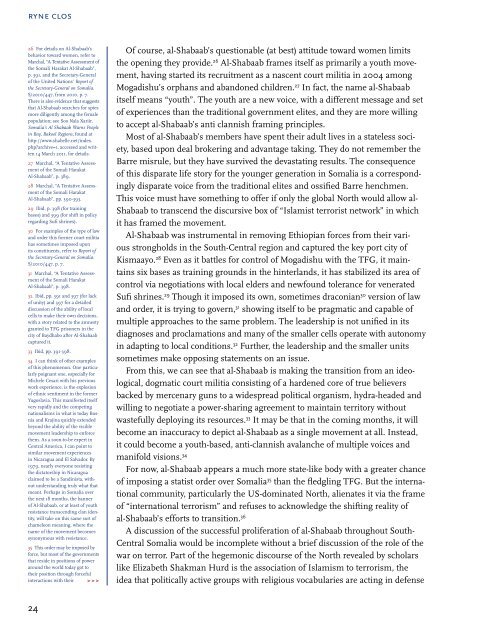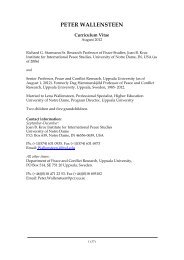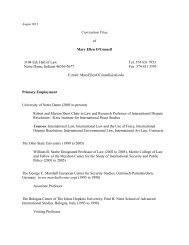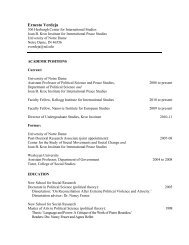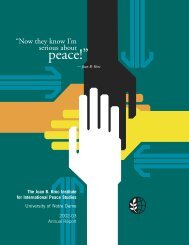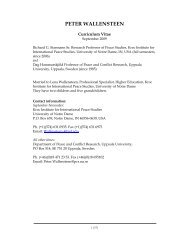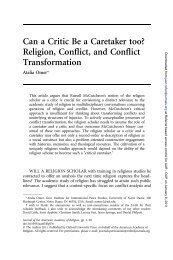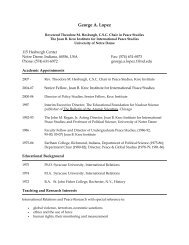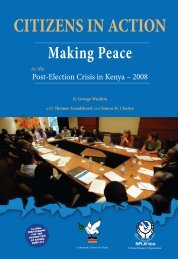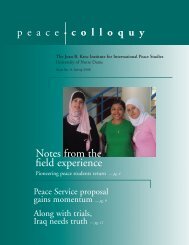Somalia: Creating Space for Fresh Approaches to Peacebuilding
Somalia: Creating Space for Fresh Approaches to Peacebuilding
Somalia: Creating Space for Fresh Approaches to Peacebuilding
You also want an ePaper? Increase the reach of your titles
YUMPU automatically turns print PDFs into web optimized ePapers that Google loves.
yne clos<br />
26 For details on Al-Shabaab’s<br />
behavior <strong>to</strong>ward women, refer <strong>to</strong><br />
Marchal, “A Tentative Assessment of<br />
the Somali Harakat Al-Shabaab”,<br />
p. 391, and the Secretary-General<br />
of the United Nations’ Report of<br />
the Secretary-General on <strong>Somalia</strong>.<br />
S/2010/447, from 2010, p. 7.<br />
There is also evidence that suggests<br />
that Al-Shabaab searches <strong>for</strong> spies<br />
more diligently among the female<br />
population; see Soo Nala Xariir,<br />
<strong>Somalia</strong>’s Al Shabaab Warns People<br />
in Bay, Bakool Regions, found at<br />
http://www.shabelle.net/index.<br />
php?archive=1, accessed and written<br />
14 March 2011, <strong>for</strong> details.<br />
27 Marchal, “A Tentative Assessment<br />
of the Somali Harakat<br />
Al-Shabaab”, p. 389.<br />
28 Marchal, “A Tentative Assessment<br />
of the Somali Harakat<br />
Al-Shabaab”, pp. 390-393.<br />
29 Ibid, p. 398 (<strong>for</strong> training<br />
bases) and 399 (<strong>for</strong> shift in policy<br />
regarding Sufi shrines).<br />
30 For examples of the type of law<br />
and order this <strong>for</strong>mer court militia<br />
has sometimes imposed upon<br />
its constituents, refer <strong>to</strong> Report of<br />
the Secretary-General on <strong>Somalia</strong>.<br />
S/2010/447, p. 7.<br />
31 Marchal, “A Tentative Assessment<br />
of the Somali Harakat<br />
Al-Shabaab”, p. 398.<br />
32 Ibid, pp. 391 and 397 (<strong>for</strong> lack<br />
of unity) and 397 <strong>for</strong> a detailed<br />
discussion of the ability of local<br />
cells <strong>to</strong> make their own decisions,<br />
with a s<strong>to</strong>ry related <strong>to</strong> the amnesty<br />
granted <strong>to</strong> TFG prisoners in the<br />
city of Baydhabo after Al-Shabaab<br />
captured it.<br />
33 Ibid, pp. 391-398.<br />
34 I can think of other examples<br />
of this phenomenon. One particularly<br />
poignant one, especially <strong>for</strong><br />
Michele Cesari with his previous<br />
work experience, is the explosion<br />
of ethnic sentiment in the <strong>for</strong>mer<br />
Yugoslavia. This manifested itself<br />
very rapidly and the competing<br />
nationalisms in what is <strong>to</strong>day Bosnia<br />
and Krajina quickly extended<br />
beyond the ability of the visible<br />
movement leadership <strong>to</strong> en<strong>for</strong>ce<br />
them. As a soon-<strong>to</strong>-be expert in<br />
Central America, I can point <strong>to</strong><br />
similar movement experiences<br />
in Nicaragua and El Salvador. By<br />
1979, nearly everyone resisting<br />
the dicta<strong>to</strong>rship in Nicaragua<br />
claimed <strong>to</strong> be a Sandinista, without<br />
understanding truly what that<br />
meant. Perhaps in <strong>Somalia</strong> over<br />
the next 18 months, the banner<br />
of Al-Shabaab, or at least of youth<br />
resistance transcending clan identity,<br />
will take on this same sort of<br />
chameleon meaning, where the<br />
name of the movement becomes<br />
synonymous with resistance.<br />
35 This order may be imposed by<br />
<strong>for</strong>ce, but most of the governments<br />
that reside in positions of power<br />
around the world <strong>to</strong>day got <strong>to</strong><br />
their position through <strong>for</strong>ceful<br />
interactions with their > > ><br />
24<br />
Of course, al-Shabaab’s questionable (at best) attitude <strong>to</strong>ward women limits<br />
the opening they provide. 26 Al-Shabaab frames itself as primarily a youth movement,<br />
having started its recruitment as a nascent court militia in 2004 among<br />
Mogadishu’s orphans and abandoned children. 27 In fact, the name al-Shabaab<br />
itself means “youth”. The youth are a new voice, with a different message and set<br />
of experiences than the traditional government elites, and they are more willing<br />
<strong>to</strong> accept al-Shabaab’s anti clannish framing principles.<br />
Most of al-Shabaab’s members have spent their adult lives in a stateless society,<br />
based upon deal brokering and advantage taking. They do not remember the<br />
Barre misrule, but they have survived the devastating results. The consequence<br />
of this disparate life s<strong>to</strong>ry <strong>for</strong> the younger generation in <strong>Somalia</strong> is a correspondingly<br />
disparate voice from the traditional elites and ossified Barre henchmen.<br />
This voice must have something <strong>to</strong> offer if only the global North would allow al-<br />
Shabaab <strong>to</strong> transcend the discursive box of “Islamist terrorist network” in which<br />
it has framed the movement.<br />
Al-Shabaab was instrumental in removing Ethiopian <strong>for</strong>ces from their various<br />
strongholds in the South-Central region and captured the key port city of<br />
Kismaayo. 28 Even as it battles <strong>for</strong> control of Mogadishu with the TFG, it maintains<br />
six bases as training grounds in the hinterlands, it has stabilized its area of<br />
control via negotiations with local elders and newfound <strong>to</strong>lerance <strong>for</strong> venerated<br />
Sufi shrines. 29 Though it imposed its own, sometimes draconian 30 version of law<br />
and order, it is trying <strong>to</strong> govern, 31 showing itself <strong>to</strong> be pragmatic and capable of<br />
multiple approaches <strong>to</strong> the same problem. The leadership is not unified in its<br />
diagnoses and proclamations and many of the smaller cells operate with au<strong>to</strong>nomy<br />
in adapting <strong>to</strong> local conditions. 32 Further, the leadership and the smaller units<br />
sometimes make opposing statements on an issue.<br />
From this, we can see that al-Shabaab is making the transition from an ideological,<br />
dogmatic court militia consisting of a hardened core of true believers<br />
backed by mercenary guns <strong>to</strong> a widespread political organism, hydra-headed and<br />
willing <strong>to</strong> negotiate a power-sharing agreement <strong>to</strong> maintain terri<strong>to</strong>ry without<br />
wastefully deploying its resources. 33 It may be that in the coming months, it will<br />
become an inaccuracy <strong>to</strong> depict al-Shabaab as a single movement at all. Instead,<br />
it could become a youth-based, anti-clannish avalanche of multiple voices and<br />
manifold visions. 34<br />
For now, al-Shabaab appears a much more state-like body with a greater chance<br />
of imposing a statist order over <strong>Somalia</strong> 35 than the fledgling TFG. But the international<br />
community, particularly the US-dominated North, alienates it via the frame<br />
of “international terrorism” and refuses <strong>to</strong> acknowledge the shifting reality of<br />
al-Shabaab’s ef<strong>for</strong>ts <strong>to</strong> transition. 36<br />
A discussion of the successful proliferation of al-Shabaab throughout South-<br />
Central <strong>Somalia</strong> would be incomplete without a brief discussion of the role of the<br />
war on terror. Part of the hegemonic discourse of the North revealed by scholars<br />
like Elizabeth Shakman Hurd is the association of Islamism <strong>to</strong> terrorism, the<br />
idea that politically active groups with religious vocabularies are acting in defense


